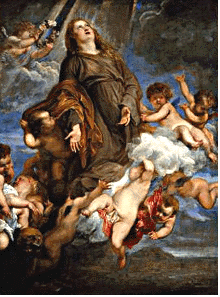...Best of Sicily presents... Best of Sicily Magazine. ... Dedicated to Sicilian art, culture, history, people, places and all things Sicilian. |
by Vincenzo Salerno | ||
Magazine Index Best of Sicily Arts & Culture Fashion Food & Wine History & Society About Us Travel Faqs Contact Map of Sicily |
It is thought that Saint Rosalie was born into a noble Norman family around 1130. Choosing the life of a hermit, she went to live in a cave on Mount Pellegrino overlooking Palermo. She is believed to have died around 1164, without ever having founded a convent or anything like a religious order. Indeed, very little was ever known of her until after the Middle Ages, when Baroque minds sought to embellish her legend. It was during the "Plague of 1624" that Saint Rosalie reputedly appeared first to a sick woman. Later, appearing to a hunter, she revealed the location of her remains in the cave and told him to bring her bones down to Palermo. These relics were found on 15 July and borne in procession throughout the quarantined city. The plague then ceased. Miracles aside, competent medical care and generally better sanitary conditions might have yielded the same effect. Throughout the modern era Palermo's "popolino" (common people) have been left mostly to their own limited resources, and today the economic lot of the crowds who celebrate Saint Rosalie's annual festival is little better than that of their seventeenth-century ancestors. Anthony van Dyck (1599-1641) was working in the city that summer, and created the painting shown here (Saint Rosalie Interceding for the Plague-stricken of Palermo). In fact, the saint's "official" ecclesiastical feast day is observed on 4 September. In typically Palermitan fashion, many locals take both 15 July and 4 September off from work. Truth be told, we know not whether the bones found in the cave were those of Saint Rosalie. We don't even know if she was actually Norman. Some scholars have suggested, based on a dearth of contemporary twelfth-century evidence, that she may never have actually existed. However, a chapel was built in the cave and she became the city's patroness. In the process, the name "Rosalia" became, and remains, very popular in Palermo --while pilgrimages to Mount Pellegrino are less frequent than in times past. Only in 1630 did the Catholic Church formally recognise Rosalie's sanctity. About the Author: Palermo native Vincenzo Salerno has written biographies of several famous Sicilians, including Frederick II and Giuseppe di Lampedusa. | |
Top of Page |
 It
is perhaps one of the ironies of Sicilian culture that the heavenly
patroness of Palermo, the island's largest city, is a shadowy figure about
whom little is known. Yet her feast in mid July is one of Sicily's largest.
It
is perhaps one of the ironies of Sicilian culture that the heavenly
patroness of Palermo, the island's largest city, is a shadowy figure about
whom little is known. Yet her feast in mid July is one of Sicily's largest.